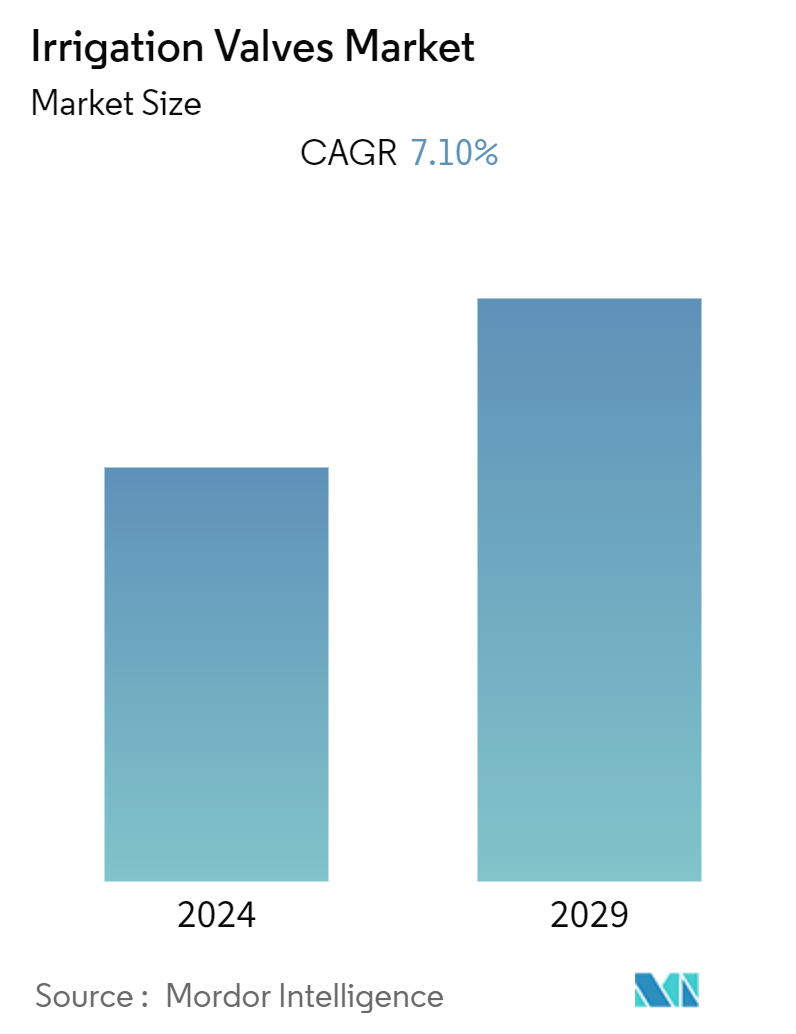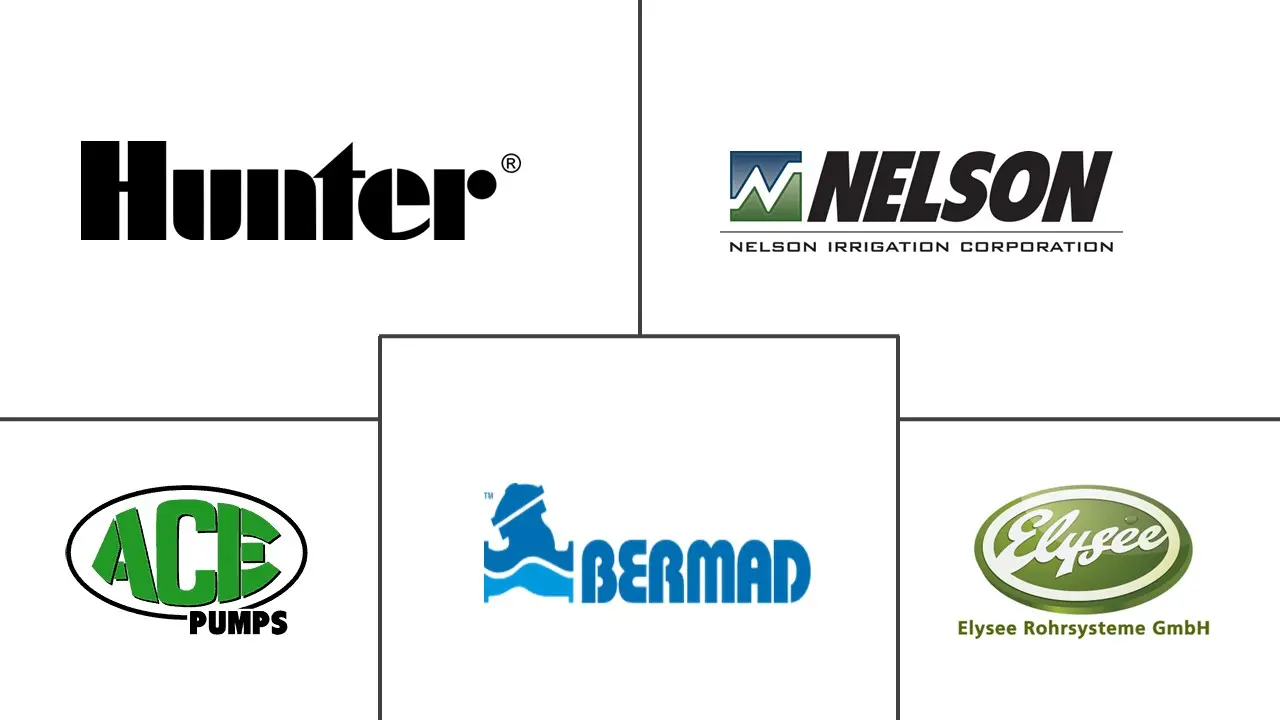Market Size of Irrigation Valves Industry

| Study Period | 2019 - 2029 |
| Base Year For Estimation | 2023 |
| CAGR (2024 - 2029) | 7.10 % |
| Fastest Growing Market | Asia Pacific |
| Largest Market | North America |
| Market Concentration | Medium |
Major Players
*Disclaimer: Major Players sorted in no particular order |
Irrigation Valves Market Analysis
The Irrigation Valves Market is expected to register a CAGR of 7.10% during the forecast period.
Irrigation Valves control the rate of water flow in an irrigation system. This is achieved by maintaining water pressure to either increase or decrease the speed at which it flows through a pipe. They control this limit using valves inside them, allowing for high-volume discharges with minimum user effort.
- The growing need for water conservation, increasing demand for food crops, and support from various government initiatives further drive market growth. Furthermore, in November 2022, the Central government added a few more objectives in Pradhan Mantri Krishi Sinchayee Yojana (PMKSY) for agriculture & irrigation.
- The goals include the Convergence of investments in irrigation at the field level, Expanding cultivable area under assured irrigation, Enhancing adoption of other water-saving technologies (More crops per drop), Enhance the adoption of precision irrigation, Improving on-farm water use efficiency to decrease wastage of water, Attract more excellent private investment in the precision irrigation system and many more.
- Technological developments in the agricultural sector may further fuel demand in the studied market. In October 2022, Rivulis India launched a unique tool to help Indian farmers make informed decisions about irrigation essentials in their fields. This tool is free for customers and available in the Indian vernacular language for farmers.
- Furthermore, increasing the agricultural land under cultivation will significantly expand the demand for irrigation valves to monitor crops easily. Moreover, China has the most significant area equipped for irrigation, as the area under arable land accounted for 118.9 thousand hectares. Agriculture contributes approximately 3.4% to China's GDP. Farming accounts for about 65% of water use in China. It is also Iis one of the highest producers and consumers of water-intensive crops, such as rice and corn.
- Furthermore, in January 2022, the U.S. Department of Agriculture NRCS announced several recent and expanded opportunities for climate-smart agriculture in the country. NRCS further collaborated with Farmers For Soil Health, the United Soybean Board initiative, the National Corn Growers Association, and the National Pork Board. Farmers For Soil Health works to advance soil health practices, mainly covering crops on corn and soybean farms. The initiative aims to double the farming of soybean and corn using cover crops to 30 million acres by 2030.
Irrigation Valves Industry Segmentation
An Irrigation Valve regulates the one-directional flow of water in an irrigation system. These valves are usually found in sprinkler systems used for parks, golf courses, and home grounds. They help control water flow in above-ground and in-ground systems planted well beneath the surface to present a less cluttered, more attractive landscape.
The Irrigation valves market is segmented by material type (metal valves, plastic valves), by valve type (ball valve, butterfly valve, globe valve, automatic valves), by application (agricultural, non-agricultural), by Geography (North America, Europe, Asia-Pacific, Latin America, Middle East and Africa). The report offers market forecasts and size in value (USD) for all the above segments.
| By Material Type | |
| Metal Valves | |
| Plastic Valves |
| By Valve Type | |
| Ball Valve | |
| Butterfly Valve | |
| Globe Valve | |
| Automatic Valves |
| By Application | |
| Agricultural | |
| Non-Agricultural |
| By Geography*** | |
| North America | |
| Europe | |
| Asia | |
| Australia and New Zealand | |
| Latin America | |
| Middle East and Africa |
Irrigation Valves Market Size Summary
The Irrigation Valves Market is poised for significant growth, driven by the increasing need for water conservation and the rising demand for food crops. Government initiatives, such as the Pradhan Mantri Krishi Sinchayee Yojana in India, are promoting water-saving technologies and precision irrigation, further propelling market expansion. Technological advancements in agriculture, like Rivulis India's new irrigation decision tool, are also contributing to market growth. The demand for irrigation valves is expected to rise as agricultural land under cultivation expands, particularly in regions like China, where agriculture is a major water consumer. The market is characterized by the introduction of innovative products, such as Flomatic Valves' Model 408S6 and GF Piping Systems' Ball Valve 543, which cater to various industrial and agricultural applications.
In India, the agricultural sector's significance is underscored by its contribution to the economy and employment. The government's supportive policies and investments, including the Production-Linked Incentive scheme and the PM-KISAN initiative, are expected to drive the demand for irrigation valves. The market is moderately competitive, with key players like Fitok Group and Lumo focusing on expanding their global presence and enhancing product offerings. Recent developments, such as Toro Ag's new valve standard and Viridis Ltd.'s advanced Precision Irrigation System, highlight the industry's commitment to innovation and efficiency. These efforts aim to optimize water use and improve crop quality, addressing the challenges posed by water scarcity and population growth.
Irrigation Valves Market Size - Table of Contents
-
1. MARKET INSIGHTS
-
1.1 Market Overview
-
1.2 Industry Attractiveness - Porter's Five Forces Analysis
-
1.2.1 Bargaining Power of Suppliers
-
1.2.2 Bargaining Power of Buyers
-
1.2.3 Threat of New Entrants
-
1.2.4 Threat of Substitutes
-
1.2.5 Intensity of Competitive Rivalry
-
-
1.3 Industry Value Chain Analysis
-
1.4 Assessment of Impact of COVID-19 on the Market
-
-
2. MARKET SEGMENTATION
-
2.1 By Material Type
-
2.1.1 Metal Valves
-
2.1.2 Plastic Valves
-
-
2.2 By Valve Type
-
2.2.1 Ball Valve
-
2.2.2 Butterfly Valve
-
2.2.3 Globe Valve
-
2.2.4 Automatic Valves
-
-
2.3 By Application
-
2.3.1 Agricultural
-
2.3.2 Non-Agricultural
-
-
2.4 By Geography***
-
2.4.1 North America
-
2.4.2 Europe
-
2.4.3 Asia
-
2.4.4 Australia and New Zealand
-
2.4.5 Latin America
-
2.4.6 Middle East and Africa
-
-
Irrigation Valves Market Size FAQs
What is the current Irrigation Valves Market size?
The Irrigation Valves Market is projected to register a CAGR of 7.10% during the forecast period (2024-2029)
Who are the key players in Irrigation Valves Market?
Ace Pump Corporation, Bermad CS Ltd, Elysee Rohrsysteme GmbH, Hunter Industries and Nelson Irrigation are the major companies operating in the Irrigation Valves Market.

